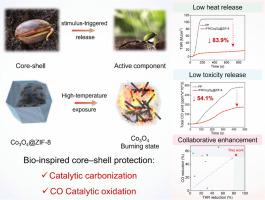Bioinspired delayed-exposure Co3O4@ZIF-8 nanoreactor for decoupled charring and CO oxidation in polypropylene composites
IF 7.4
2区 化学
Q1 POLYMER SCIENCE
引用次数: 0
Abstract
Conventional intumescent flame retardants typically generate localized hypoxic environments within the char layer, leading to incomplete carbonization and substantial CO emission, particularly in intrinsically flammable polyolefins. Metal oxides, owing to their high catalytic activity and tunable redox states, have emerged as promising additives for smoke suppression and toxicity mitigation in polyolefin systems. However, excessive catalytic activity can concurrently accelerate oxidative decomposition of the protective char. Inspired by the protective architecture and stimuli-responsive release of natural seeds, we report a bioinspired interfacial chemical engineering strategy to construct a core–shell Co3O4@ZIF-8 catalyst. This confinement architecture enables spatiotemporal decoupling of char formation and CO oxidation. During early combustion, the catalyst facilitates the rapid formation of a compact char barrier serving as an efficient thermal shield. Upon reaching elevated temperatures, Co3O4 becomes exposed via the ZIF-8 carrier, efficiently catalyzing CO oxidation and markedly reducing toxic emissions. This strategy achieves a 91.7 % reduction in the peak heat release rate (PHRR), an 83.9 % decrease in total heat release (THR), and a 54.1 % reduction in CO emission, while delivering outstanding flame-retardant performance (LOI=32 %, UL-94 V-0 rating). Collectively, this work establishes a bioinspired core–shell confined catalyst for simultaneous fire safety and toxicity suppression in flame-retardant polypropylene.

生物启发延迟暴露Co3O4@ZIF-8纳米反应器用于聚丙烯复合材料的去耦炭化和CO氧化
传统的膨胀型阻燃剂通常在炭层内产生局部缺氧环境,导致不完全碳化和大量CO排放,特别是在本质上易燃的聚烯烃中。金属氧化物由于其高催化活性和可调节的氧化还原状态,已成为聚烯烃系统中有前途的抑烟和减毒添加剂。然而,过度的催化活性会同时加速保护炭的氧化分解。受天然种子的保护结构和刺激反应释放的启发,我们报告了一种生物启发界面化学工程策略来构建核壳Co3O4@ZIF-8催化剂。这种约束结构使炭形成和CO氧化的时空解耦成为可能。在早期燃烧过程中,催化剂有助于快速形成致密的炭屏障,作为有效的热屏蔽。当达到高温时,Co3O4通过ZIF-8载体暴露,有效地催化CO氧化,显著减少有毒物质的排放。该策略实现了峰值放热率(PHRR)降低91.7%,总放热率(THR)降低83.9%,CO排放量降低54.1%,同时具有出色的阻燃性能(LOI= 32%, UL-94 V-0等级)。总的来说,这项工作建立了一种生物启发的核壳限制催化剂,同时用于阻燃聚丙烯的防火安全和毒性抑制。
本文章由计算机程序翻译,如有差异,请以英文原文为准。
求助全文
约1分钟内获得全文
求助全文
来源期刊

Polymer Degradation and Stability
化学-高分子科学
CiteScore
10.10
自引率
10.20%
发文量
325
审稿时长
23 days
期刊介绍:
Polymer Degradation and Stability deals with the degradation reactions and their control which are a major preoccupation of practitioners of the many and diverse aspects of modern polymer technology.
Deteriorative reactions occur during processing, when polymers are subjected to heat, oxygen and mechanical stress, and during the useful life of the materials when oxygen and sunlight are the most important degradative agencies. In more specialised applications, degradation may be induced by high energy radiation, ozone, atmospheric pollutants, mechanical stress, biological action, hydrolysis and many other influences. The mechanisms of these reactions and stabilisation processes must be understood if the technology and application of polymers are to continue to advance. The reporting of investigations of this kind is therefore a major function of this journal.
However there are also new developments in polymer technology in which degradation processes find positive applications. For example, photodegradable plastics are now available, the recycling of polymeric products will become increasingly important, degradation and combustion studies are involved in the definition of the fire hazards which are associated with polymeric materials and the microelectronics industry is vitally dependent upon polymer degradation in the manufacture of its circuitry. Polymer properties may also be improved by processes like curing and grafting, the chemistry of which can be closely related to that which causes physical deterioration in other circumstances.
 求助内容:
求助内容: 应助结果提醒方式:
应助结果提醒方式:


